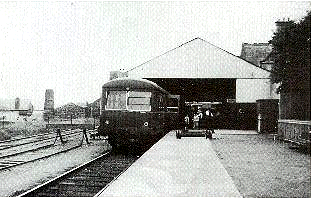
Waterford & Tramore Railway --: End of an Era

The first diesel engine arrives in 1954
The end of the steam train came suddenly and unexpectantly in November 1954,when one of the engines broke down and was replaced by a diesel engine. There was no announcement, they just replaced a steam engine for a diesel engine. There was much opposition to this development but the townspeople could not stand in the way of progress.
When the summer season of 1955 arrived it was found that the railcars could not cope with the heavy traffic on the line. A lot of money would have to be found to replace the rolling stock and upgrade the line and facilities. Despite gallant efforts the money to improve the line was not found. Waterford Corporation decided instead to put on extra buses at peak periods to cater for the numbers of people travelling to and from Tramore. The railway was dying slowly.
In 1954 the old railway shed in Manor Street was demolished. The steam engines, which
had given such good service over the years, were left lying at a siding in Manor Street to
rust away. They were removed in 1955 and were scrapped. In the winter of 1955 the booking
offices at Waterford and Tramore were closed, only to open at peak times and during busy
summer months.
The closing years of the railway were troubled times. With many people now able to afford
their own cars the numbers using the train service began to dwindle. In the early 1950
Coras Iompair Eireann (formerly Great Southern Railways) took over the running of the
line. They maintained that due to rising costs and lack of public support they would have
to reconsider their options to keep the line open or to close. To many observers the end
of the railway was near. Business interests from Waterford and Tramore approached the
Corporation for help.
In 1952 cheap fares were introduced with great success. Fourteen trains per day were now running in both directions and all traffic records were broken. Queues began to form again and there was little room on each carriage. Many people felt that the line was saved. But it was not to be.
Introduction
Early History First Train Developments
Accidents Steam Close
![]()
![]()
![]()
![]()
![]()
![]()
![]()
![]()
![]()
![]()
![]()
![]()
![]()